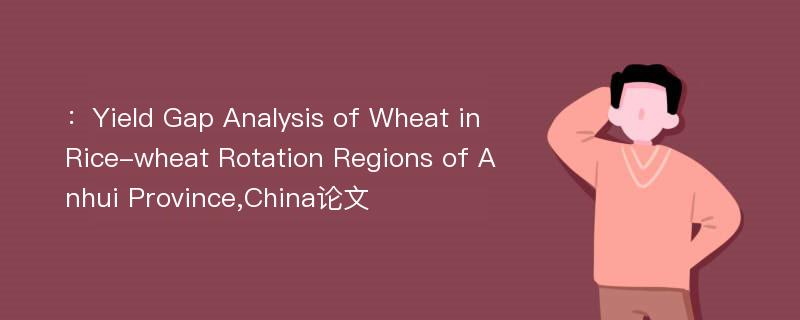
本文主要研究内容
作者(2019)在《Yield Gap Analysis of Wheat in Rice-wheat Rotation Regions of Anhui Province,China》一文中研究指出:The present study was planned to analyze the yield gap of wheat and its production constraints in order to explore the approaches for narrowing the yield gap of wheat in different wheat-rice rotation regions of Anhui Province. The production status and limiting factors of wheat in three rice-wheat rotation regions which are named Region Ⅰ,Region Ⅱ and Region Ⅲ were surveyed by using participatory rural appraisal method. The personnel,who were engaged in wheat production in rice-wheat rotation regions of Anhui Province,mainly ageing from 41 to 60,accounted for 79% of the total personnel in the regions. There were significant differences in yield of wheat which was planted after rice in Anhui. The yield was ranging from 8 907. 00 to 2 700. 00 kg/ha from north to south with an average of 4 978. 5 kg/ha,and the rank of overall average yields at province level was Region Ⅰ( 5 685. 60 kg/ha) > Region Ⅱ( 5 600. 10 kg/ha) > Region Ⅲ( 3 048. 60 kg/ha). The average yield gap of wheat in wheat-rice rotation regions at province level was up to 2 637. 00 kg/ha,and the extreme yield gaps per hectare in the same region were 2 778. 00 kg( Region Ⅰ),2 502. 00 kg( Region Ⅱ) and 1 575. 00 kg( Region Ⅲ) respectively. The objective constraints were Fusarium head blight and pre-harvest sprouting; the subjective constraints were variety selection and layout,poor sowing quality and low seedling quality; social constraints were high cost,low market price and poor efficiency; and ecological constraints were poor soil texture,soil infertility and poor water-and-fertilizer retention. The yield gap of wheat in rice-wheat rotation regions can be effectively reduced by improving yield potential of low-and-medium-yielding fields. Selecting appropriate wheat varieties and layout,constructing disease forecast system,improving agricultural machinery and social service organizations of plant protection,and strengthening scientific training as well as technological training of new agricultural operators and agricultural machinery technicians are the core means to narrowing the yield gap of wheat in rice-wheat rotation regions at province scale.
Abstract
The present study was planned to analyze the yield gap of wheat and its production constraints in order to explore the approaches for narrowing the yield gap of wheat in different wheat-rice rotation regions of Anhui Province. The production status and limiting factors of wheat in three rice-wheat rotation regions which are named Region Ⅰ,Region Ⅱ and Region Ⅲ were surveyed by using participatory rural appraisal method. The personnel,who were engaged in wheat production in rice-wheat rotation regions of Anhui Province,mainly ageing from 41 to 60,accounted for 79% of the total personnel in the regions. There were significant differences in yield of wheat which was planted after rice in Anhui. The yield was ranging from 8 907. 00 to 2 700. 00 kg/ha from north to south with an average of 4 978. 5 kg/ha,and the rank of overall average yields at province level was Region Ⅰ( 5 685. 60 kg/ha) > Region Ⅱ( 5 600. 10 kg/ha) > Region Ⅲ( 3 048. 60 kg/ha). The average yield gap of wheat in wheat-rice rotation regions at province level was up to 2 637. 00 kg/ha,and the extreme yield gaps per hectare in the same region were 2 778. 00 kg( Region Ⅰ),2 502. 00 kg( Region Ⅱ) and 1 575. 00 kg( Region Ⅲ) respectively. The objective constraints were Fusarium head blight and pre-harvest sprouting; the subjective constraints were variety selection and layout,poor sowing quality and low seedling quality; social constraints were high cost,low market price and poor efficiency; and ecological constraints were poor soil texture,soil infertility and poor water-and-fertilizer retention. The yield gap of wheat in rice-wheat rotation regions can be effectively reduced by improving yield potential of low-and-medium-yielding fields. Selecting appropriate wheat varieties and layout,constructing disease forecast system,improving agricultural machinery and social service organizations of plant protection,and strengthening scientific training as well as technological training of new agricultural operators and agricultural machinery technicians are the core means to narrowing the yield gap of wheat in rice-wheat rotation regions at province scale.
论文参考文献
论文详细介绍
论文作者分别是来自Asian Agricultural Research的,发表于刊物Asian Agricultural Research2019年11期论文,是一篇关于,Asian Agricultural Research2019年11期论文的文章。本文可供学术参考使用,各位学者可以免费参考阅读下载,文章观点不代表本站观点,资料来自Asian Agricultural Research2019年11期论文网站,若本站收录的文献无意侵犯了您的著作版权,请联系我们删除。
